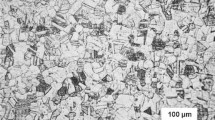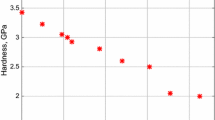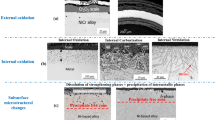Abstract
Valuable insights into the wear-corrosion behavior of metals, as well as into the tribocorrosion field through the development of simulation models of tribocorrosion experiments, can contribute in rationalizing wear-accelerated experiments and their open circuit potential (OCP) behavior under rubbing. These results demonstrate that mathematical models of controlled tribo-electrochemical contacts can complement the physical experiment and add valuable understanding to the tribological behavior of metals, alloys, and generally to materials in an electrochemically active environment. The excellent agreement of experimental wear data and the experimental OCP curves with the OCP simulations with time establishes the concepts underlying the galvanic coupling model as a valid methodological approach toward a quantitative description and mechanistic understanding of the tribo-electrochemical experiment. Besides analyzing stellite tribocorrosion, application of the model to Al alloy data has helped us quantify the relative contributions of chemical and mechanical wear and reveal the underlying synergy. Ti metal tribocorrosion under variable load has revealed that the contact pressure P av, can reach much lower values within the experimental time domain and finally be the cause of interruption of the initial wear mechanism.











Similar content being viewed by others
References
Landolt, D., Mischler, S., Stemp, M.: Electrochemical methods in tribocorrosion: a critical appraisal. Electrochim. Acta 46, 3913–3929 (2001)
Jemmely, P., Mischler, S., Landolt, D.: Electrochemical modeling of passivation phenomena in tribocorrosion. Wear 237, 63–76 (2000)
Olsson, C.-O.A., Landolt, D.: Passive films on stainless steels—chemistry, structure and growth. Electrochim. Acta 48, 1093–1104 (2003)
Burstein, G.T., Liu, C.: Time-resolved electrochemical impedance of the guillotined aluminium electrode. Electrochim. Acta 39, 873–882 (1994)
Burstein, G.T., Organ, R.M.: Repassivation and pitting of freshly generated aluminium surfaces in acidic nitrate solution. Corros. Sci. 47, 2932–2955 (2005)
Vieira, A.C., Rocha, L.A., Papageorgiou, N., Mischler, S.: Mechanical and electrochemical deterioration mechanisms in the tribocorrosion of Al alloys in NaCl and in NaNO3 solutions. Corros. Sci. 54, 26–35 (2012)
Julian, L.C., Munoz, A.I.: Influence of microstructure of HC CoCrMo biomedical alloys on the corrosion and wear behaviour in simulated body fluids. Tribol. Int. 44, 318–329 (2011)
Cawley, J., Metcalf, J.E.P., Jones, A.H., Band, T.J., Skupien, D.S.: A tribological study of cobalt chromium molybdenum alloys used in metal-on-metal resurfacing hip arthroplasty. Wear 255, 999–1006 (2003)
Munoz, A.I., Julian, L.C.: Influence of electrochemical potential on the tribocorrosion behaviour of high carbon CoCrMo biomedical alloy in simulated body fluids by electrochemical impedance spectroscopy. Electrochim. Acta 55(19), 5428–5439 (2010)
Benea, L., Ponthiaux, P., Wenger, F., Galland, J., Hertz, D., Malo, J.Y.: Tribocorrosion of stellite 6 in sulphuric acid medium: electrochemical behaviour and wear. Wear 256(9–10), 948–953 (2004)
Stack, M.M., Huang, W., Wang, G., Hodge, C.: Some views on the construction of bio-tribo-corrosion maps for titanium alloys in Hank’s solution: particle concentration and applied loads effects. Tribol. Int. 44, 1827–1837 (2011)
Galliano, F., Galvanetto, E., Mischler, S., Landolt, D.: Tribocorrosion behavior of plasma nitrided Ti6Al4 V alloy in neutral NaCl solution. Surf. Coat. Technol. 145, 121–131 (2001)
Mischler, S.: Triboelectrochemical techniques and interpretation methods in tribocorrosion: a comparative evaluation. Tribol. Int. 41, 573–583 (2008)
Barril, S., Mischler, S., Landolt, D.: Influence of fretting regimes on the tribocorrosion behaviour of Ti6Al4 V in 0.9 wt% sodium chloride solution. Wear 256, 963–972 (2004)
Mindivan, H., Baydogan, M., Kayali, E.S., Cimenoglu, H.: Wear behaviour of 7039 aluminum alloy. Mater. Charact. 54, 263 (2005)
Bouaeshi, W.B., Li, D.Y.: Effects of Y2O3 addition on microstructure, mechanical properties, electrochemical behavior and resistance to corrosive wear of aluminum. Tribol. Int. 40, 188–199 (2007)
Li, J., Elmadagli, M., Gertsman, V.Y., Lo, J., Alpas, A.T.: FIB and TEM characterization of subsurfaces of an Al–Si alloy (A390) subjected to sliding wear. Mater. Sci. Eng.A 421, 317–327 (2006)
Landolt, D.: Corrosion and Surfaces Chemistry of Metals, 1st (edn). EPFL Press, Lausanne (2007)
Krawiec, H., Vignal, V., Heintz, O., Ponthiaux, P., Wenger, F.: Local electrochemical studies and surface analysis on worn surfaces. J Electrochem Soc 155(3), C127–C130 (2008)
Landolt, D., Mischler, S., Stemp, M.: Electrochemical methods in tribocorrosion: a critical appraisal. Electrochim. Acta 46(24–25), 3913–3929 (2001)
Stojadinovic, J., Bouvet, D., Declercq, M., Mischler, S.: Effect of electrode potential on the tribocorrosion of tungsten. Tribol. Int. 42, 575–583 (2009)
Barril, S., Mischler, S., Landolt, D.: Electrochemical effects on the fretting corrosion behavior of Ti6Al4 V in 0.9 % sodium chloride solution. Wear 259, 282–291 (2005)
Hamrock, B.J., Dowson, D.: Ball Bearing Lubrication—The Elastohydrodynamics of Elliptical Contacts. Wiley, New York (1981)
Vieira, A.C., Pinto, A.M., Rocha, L.A., Mischler, S.: Effect of Al2Cu precipitates size and mass transport on the polarisation behavior of age-hardened Al–Si–Cu–Mg alloys in 0.05 M NaCl. Electrochim. Acta 56, 3821–3828 (2011)
Kröger, F.A.: The Chemistry of Imperfect Crystals, 2nd edn. Elsevier, New York (1973)
Boxley, C.J., White, H.S., Gardner, C.E., Macpherson, J.V.: Nanoscale imaging of the electronic conductivity of the native oxide film on titanium using conducting atomic force microscopy. J. Phys. Chem. B 107, 9677–9680 (2003)
Acknowledgments
The authors wish to thank S. Guadalupe for sharing experimental data on the stellite 21 material, and N. Espallargas and the IPM-NTNU for providing materials and support in making this research possible.
Author information
Authors and Affiliations
Corresponding author
Appendix
Appendix
1.1 Hertz Pressure
Hertz’s theory is used to calculate the average pressure and maximum pressure between two non-conforming contacts. This theory was used to assess changes in maximum pressure during wear. For this purpose, the equations established by Hamrock and Dowson [23] were assumed. Therefore, the dimensions of contact (assumed elliptical) are given by Eq. I, where a is the semimajor axis and b the semiminor axis of the contact.
where \( \bar{\varepsilon } \) is a simplified integration parameter and \( \bar{k} \) a parameter of ellipticity given by
where E′ is the reduced Young’s modulus, R′ is the radius of reduced curvature, and R x and R y are the reduced radii in the x-direction and the y-direction, respectively. The x and y axes are defined as the axes of the plane of the contact, respectively, along the major axis and minor axis of the ellipse formed by it. These values are defined as
where E a and E b are the Young’s modulus values of the material of body a and body b; n a and n b their respective Poisson coefficients; R ax , R bx , R ay, and R by are the radii of curvatures of the body a along the x axis, the body b along the x axis, and body a along the y axis, and body b along this same axis, respectively.
In the case studied, it was assumed that the contact is between the sphere (i.e., the ball) and the concave track surface having a radius of curvature R by , which is considered here only slightly larger than the curvature of the ball of radius R = R ax = R ay.
According to Eq. I and II of the above method, the average contact pressure exerted by the sphere onto the concave track, under force W, is given by
Using the definitions declared in the Sect. 4 and substituting Eq. I, II into Eq. III we have
where a = 0.5 a@lim and a@lim is the wear track's width.
Rights and permissions
About this article
Cite this article
Papageorgiou, N., Mischler, S. Electrochemical Simulation of the Current and Potential Response in Sliding Tribocorrosion. Tribol Lett 48, 271–283 (2012). https://doi.org/10.1007/s11249-012-0022-9
Received:
Accepted:
Published:
Issue Date:
DOI: https://doi.org/10.1007/s11249-012-0022-9




